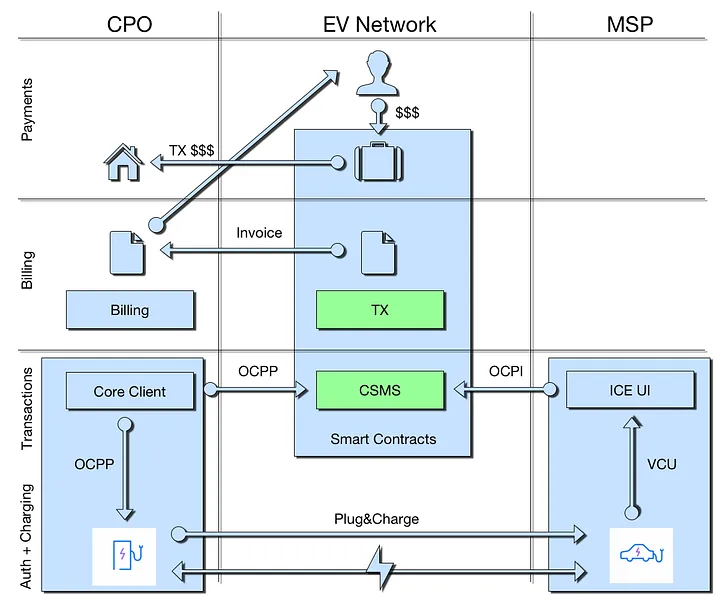Electric vehicle (EV) mobility is rapidly evolving toward a seamless, decentralized ecosystem where individuals, machines, and organizations coexist in a system powered by green energy. In this vision, manned and autonomous vehicles operate within a charging infrastructure that is distributed, trusted, and free from conventional constraints such as supplier contracts, currency restrictions, or security risks like fraud. Transactions—exchanging electricity for tokens or currency—are automated and universally accessible.
This article is the final installment in a three-part series. In the first piece, I explored the current state of EV mobility, where Mobility Service Providers (MSPs) and Charge Point Operators (CPOs) dominate the post-payment model. The second article introduced an architecture built around blockchain (e.g., Ethereum) to manage transactions in a more decentralized, pre-payment structure, reducing inefficiencies and single points of failure.
In this third and final article, I look to the horizon, envisioning a system of autonomous smart agents operating within a distributed ledger technology (DLT) framework. This evolution will redefine how EV networks are built, managed, and scaled using technologies that are becoming increasingly viable in the blockchain ecosystem.
Taking the Next Step
The first proposed architecture aimed to be minimally disruptive. CPOs could treat our Core Client like any other MSP, while MSPs interacted with the EV Network as they would with a CPO. This made the shift to a decentralized model more accessible.
However, full integration of DLT requires a deeper transformation—technical, procedural, and cultural. Our path forward involves redistributing trust and control in two key areas:
- The EV Network: Acting as the authoritative layer for managing the charging infrastructure, the network will provide participants with transparent, auditable access to all operations and outcomes, minimizing unilateral control by any one party (especially CPOs).
- Charging Points and EVs: These endpoints become the actual agents of value exchange. Empowering them to verify integrity and enforce contracts is key to decentralization.
This architecture becomes even more critical as we expand into adjacent business models—such as integrated parking systems that allow drivers to reserve charging spots—adding value to the overall EV experience.
Updated Architecture Overview
In the revised system (refer to Figure 3), the charging session flow is streamlined and automated:
- The EV obtains the station ID directly from the charging point using Plug&Charge (ISO 15118).
- With a predefined user profile, the EV can initiate charging autonomously—especially in autonomous driving scenarios.
- The EV Wallet submits a session request to the EV Network, triggered by the Vehicle Control Unit (VCU). The Core Client at the charging station picks it up.
- Tokens from both parties are placed into escrow during the session.
- Charging takes place off-chain, coordinated by smart contracts in the EV Network. The IoT devices (CP and EV) manage the actual energy transfer.
- Tokens are automatically transferred to the CPO wallet as the session progresses—no need for post-session settlements.
- The CPO can issue a transaction invoice for the driver.
Smart Contracts as the New CSMS
Previously, the Charging Station Management System (CSMS) served as the central controller within the EV Network. But what if we could migrate CSMS functionality entirely into smart contracts?
This would eliminate inefficiencies from multiple communication layers and central controllers. All transactions would be executed on the Ethereum Virtual Machine (EVM), where logic and value (tokens) are natively linked.
Though this model may seem ambitious given Ethereum’s current scalability and latency challenges, it offers long-term promise. Implementing Open Charge Point Protocol (OCPP) features via smart contracts could significantly reduce friction and increase trust between charging parties.
IoT Challenges and Opportunities
To build a machine-to-machine economy, we must develop smarter, autonomous devices capable of operating with limited oversight. This is especially important as we prepare for mainstream Vehicle-to-Grid (V2G) implementations.
The Ethereum community is actively working to enable “light” clients for resource-constrained IoT devices. The Light Ethereum Subprotocol (LES), used in Geth and Parity, allows direct, lightweight integration of EVs and charging points with the EV Network. A slimmed-down Core Client can bridge communication between the Ethereum client and the charging hardware (via OCPP).
Strengthening EVs and charging stations includes both hardware and software improvements—secure processors, cryptographic signing, smart metering (e.g., Germany’s “Eichrecht”), and access controls. Technologies like Apple’s Secure Enclave Processor (SEP) provide a model for how secure hardware can protect critical data and ensure correct behavior.
Micro-Transactions and Smart Charging
While the overarching system is decentralized and blockchain-based, the energy transfer itself is an off-chain transaction. Initially, both EV and CPO lock tokens into escrow. The actual settlement occurs when the Charge Detail Record (CDR) is submitted.
But what happens if the delivered energy doesn’t match expectations? Micro-transactions offer a solution.
By establishing a bi-directional off-chain channel between the CP and EV for each session, the energy transfer is broken down into verifiable “chunks.” Each micro-transfer of electricity is accompanied by a token transfer, validated in real-time by the EV’s VCU (e.g., via battery level monitoring).
This approach reduces risk, enhances trust, and enables advanced features like smart charging. Ethereum’s Raiden project—and specifically the µRaiden framework—offers tools for building these micro-payment systems tailored for IoT environments.
Conclusion
Across these three articles, I’ve attempted to sketch a roadmap for the future of EV mobility—moving from centralized systems to decentralized, smart-agent-powered ecosystems.
There’s still much work to be done. But as one of the early adopters contributing to this transformation, I’m optimistic that we’re heading in the right direction. The technologies are maturing, and the pieces are falling into place. It’s now up to us to turn this vision into reality.
